自制新车间 | XinCheJian DIY
XinCheJian DIY is a platform to show XinCheJian members’ projects. At the same time, people that’s interested can buy DIY kits or projects directly through this platform at a reasonable price. We guarentee that this is not a platform that accepts all the products. All the projects must be coming from XinCheJian members!
本周推荐:荧光舞道具服 | This week recommendation: Fluorescent dance cloth
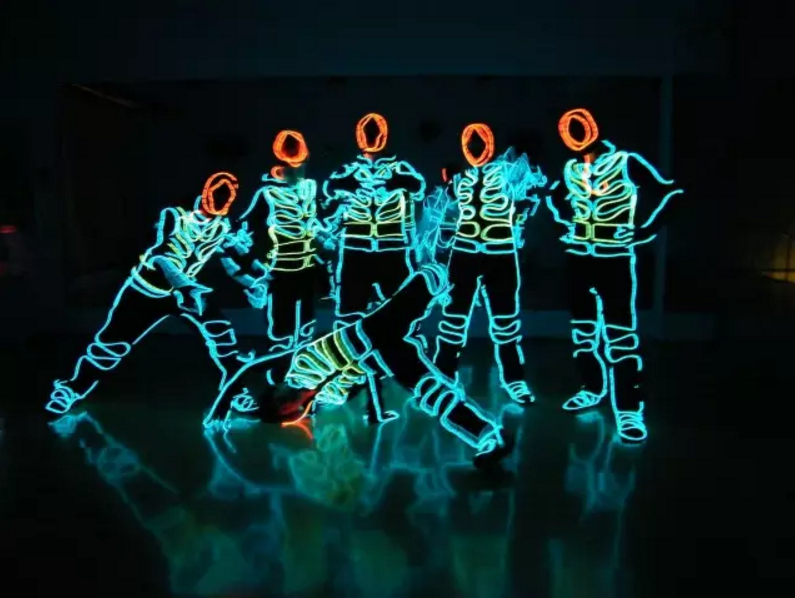 Electronic-dancing-cloths:
Cloths that have lights shining with rhythm . They can create an amazing atmosphere, and help dancers to do what will never be done without the help of the lights
How did this project happen:
This project comes from a XinCheJian high school memebr. It first occured to him to design this when he saw a cool dance on a school event. After he designed it, the dance club adopted it to the dance, and successfully used for a lot more school events.
Materials:
Clothes , trousers ,batteries , Arduino and hot glue gun, ELlight string : 5m*2 , 2m*1(freefor colors), aset of driver and wire, 12Vbattery box*3(forfree , you can use the 8*1.5V battery which is on the driver if you don’t wantto do any operations on the driver , but 8 batteries will make the clothesheavy), relay*1
Electronic-dancing-cloths:
Cloths that have lights shining with rhythm . They can create an amazing atmosphere, and help dancers to do what will never be done without the help of the lights
How did this project happen:
This project comes from a XinCheJian high school memebr. It first occured to him to design this when he saw a cool dance on a school event. After he designed it, the dance club adopted it to the dance, and successfully used for a lot more school events.
Materials:
Clothes , trousers ,batteries , Arduino and hot glue gun, ELlight string : 5m*2 , 2m*1(freefor colors), aset of driver and wire, 12Vbattery box*3(forfree , you can use the 8*1.5V battery which is on the driver if you don’t wantto do any operations on the driver , but 8 batteries will make the clothesheavy), relay*1
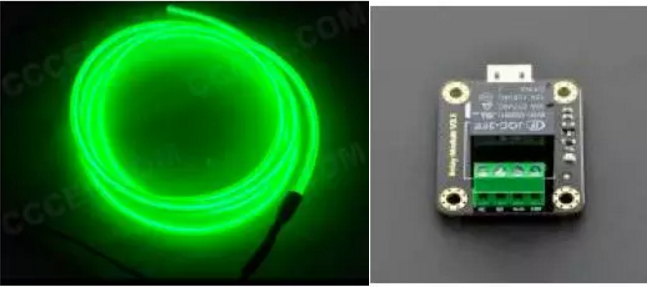 Way to DIY:
First , use glue gun to stick the light string onto the clothes as you like . Make sure that you stick the light string as the shape of muscle to make the dance more attractive .
You can get more light strings in order to change your clothes’ colors you like .
Way to DIY:
First , use glue gun to stick the light string onto the clothes as you like . Make sure that you stick the light string as the shape of muscle to make the dance more attractive .
You can get more light strings in order to change your clothes’ colors you like .
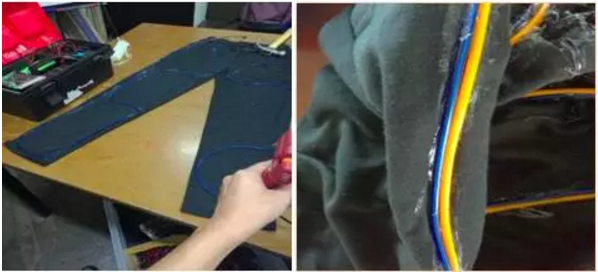 Then , put the relay in to the circuit . you can get the information about the relay on this website
It is just a simple example. And the material we give is only enough to have one combination of colors so you only need one relay.
If you’re interest in making or purchasing this, you can scan QR code below to find out more info.
Then , put the relay in to the circuit . you can get the information about the relay on this website
It is just a simple example. And the material we give is only enough to have one combination of colors so you only need one relay.
If you’re interest in making or purchasing this, you can scan QR code below to find out more info.
 ]]>
]]>
自制新车间:荧光衣 | XinCheJian DIY: Fluorescent dance cloth
November 9th, 2016 § 0 comments § permalink
Arduino入门之自动浇花系统搭建 11月20日
November 9th, 2016 § 0 comments § permalink
Huodongxing: 上海静安愚园东路28号3号楼一楼 新车间 课程介绍 随着人们生活节奏的加快,即使是最爱的花草浇水也无暇顾及,偶而出差、旅行、探亲也是很正常的事情,而家中花草谁来管理? 花草生长问题80%以上是由花儿浇灌问题引起;好不容易种植几个月的花草,因为浇水不即时,长势不好,用来美化家园的花草几乎成了“鸡肋”;因此我们为广大DIY爱好者,开发了一款可以自己编程,设置参数,自己动手组装的基于Arduino的自动浇花控制器,使用土壤湿度传感器对土壤湿度进行监测,通过温湿度传感器对室内温度、湿度进行测量,控制水泵或电池阀进行浇水,从而达到自动浇灌的目的。 此课程是基于Arduino的自动浇花套件,用户可以自己编程实现更多的功能,例如智能家居,物联网等。相关文档中提供全面的套件组装教程和调试软件,您完全不用担心安装的问题。
二、自动浇花系统技术规格及套件清单
技术规格: · 输入电源:6-12V · 支持湿度传感器和碳棒检测土壤湿度 · 支持潜水泵和双稳态电磁阀浇水 · 具有室内温度和湿度检测 · 具有土壤湿度阀值调节 · 具有4个模拟口,5个数字口 · 支持xbee无线数传 · 支持USB接口下载程序 · 具有DC2.1和接线柱电源接口 · 潜水泵额定电压:3.5-12V · 潜水泵最大扬程:200cm · 模块尺寸:70 x 60mm · 支持防水型DS18B20温度传感器 清单: · Free Life自动浇花系统控制器 1个 · Micro USB线 1根 · DHT11温湿度传感器 1个 · 土壤湿度传感器 1个 · 模拟接口转数字接口传感器连接线 2根 · 潜水泵 1个(注意:潜水泵必须在水中使用,不能露出水面!) · 潜水泵电源连接线 1根 · 主板电源连接线 1根 · 橡胶水管 1米 · 塑料外壳 1个 · 2mm一字螺丝刀 1个 · 1号十字螺丝刀 1个 · 电子文档上位机软件 1份课程内容安排
预计课程持续2~3小时 1、什么是Arduino以及arduino智能硬件平台应用 2、电路基础和简单编程知识介绍 3、自动浇花系统电子元器件介绍,包括控制模块,传感器等。 4、指导学生动手搭建 5、搭建完后指导调试以及参数设置与修改 6、点评与总结 要求: 8岁以上,小朋友最好有家长陪同。 笔记本电脑,预安装Arduino(https://www.arduino.cc/en/Main/Software )和Eagle( http://www.cadsoftusa.com/download-eagle/freeware/) 时间: 11月20日,14:00 – 17:00 价格: 新车间会员:300/人,新车间非会员:350/人 套件:300/人 报名请扫描二维码,或点击阅读原文。更多问题发送邮件至[email protected]]]>学习使用MATLAB 11月13日 | Learn how to use MATLAB November 13
November 9th, 2016 § 0 comments § permalink
Huodongxing: 上海静安愚园东路28号3号楼一楼 新车间 Time: 14:00 – 16:00, Sunday, November 13th Personal Biography: Biggerlab, set up in 2015, is devoted to cultivating talentswith STEM accomplishments for China. Bigger lab owns a team of first-ratementors and provides a whole set of sci-tech education course including Arduinohardware development, IOS programming, data visualization, VR virtual reality,etc. Biggerlab takes effort to cultivate scientific quality of Chinese studentswith zero basis in order to make them standing out from global competitions infuture. Workshop description: MATLAB is a programming language that is used by engineersand scientists for mathematical computations, including, but not limited to,matrix manipulation, plotting of functions and data, implementation ofalgorithms, and a graphical representation of the manipulation of sound andlight signals. MATLAB can be used to make higher-level mathematics a lot easierfor all purposes including calculus and statistics. In this workshop, you willlearn the basics of MATLAB. The goal of this workshop is to teach you How to simulate the sound of a musical instrument using MATLAB.Biggerlab will be providing the MATLAB program to install and experiment withits features. -Intro to MATLAB/Basic arithmetic and calculations usingMATLAB Manipulating vectors, basic MATLAB functions -Plotting of signals and statistics using MATLAB The difference between continuous-time signals,discrete-time signals, and sampled signals, and how to plot them using MATLAB;basics of convolution using graphs to generate new types of signals -Difference Equations How to plot multi-variable functions on MATLAB, determine ifit is linear, -Other functions available for higher mathematics Ellip function, freq, length, plot, how to design a low-passfilter for clearer audio, dtft command -How to simulate the sound of a musical instrument as a sumof cosine signals Using the Karplus-Strong system of equations for a gain,delay, and low-pass filter to plot on MATLAB a digital plucked-string sound -Removing an echo from a recording of a speech signal Creating the echo signal, removing the echo, and thenestimating the echo’s parameters Instructor info: Lathika, Indian by blood and heart, Lathika grew up in the ever-busycity of Shanghai. She is currently a senior at NYU Shanghai getting a major inElectrical Engineering and a minor in Natural Science, and one day she hopes tocombine her technical knowledge with her interest in serve and internationalaffairs. She has previously been involved in projects titled “GestureRecognition using Accelerometers” and “Design of a Two-Stage BJT Class AAmplifier”, and done five graduate-level courses in Electrical Engineering. Hersenior design project for NYU Shanghai aims to focus on the power consumptionof the NYU Shanghai building and the implementation of green technology oftheir Academic Building. Other than technology, she is also interested inwriting as has served as the staff writer and editor, and is currently theManaging Editor, for NYU Shanghai’s student newspaper, On Century Avenue. Fee: XinCheJIan member: 260 / person; Non-member: 300 / person.If you have questions, please send Email to [email protected]. Please bring your laptop while attending the workshop!]]>
Unity3D入门 11月12日 | Intro to Unity 3D November 12th
November 9th, 2016 § 0 comments § permalink
Huodongxing: 上海静安愚园东路28号3号楼一楼 新车间 Alan is a Senior Solutions Architect at frog design. Normally he’s advising companies on software architecture and technology strategy, but at the weekends he’s busy writing games, prototypes and interactive art, these days using Unity. He’s been programming games for over 20 years. What can Unity do? Unity is used to develop video games for PC, consoles, mobile devices and websites. Unity3D是由Unity Technologies开发的一个让玩家轻松创建诸如三维视频游戏、建筑可视化、实时三维动画等类型互动内容的多平台的综合型游戏开发工具,是一个全面整合的专业游戏引擎。Unity类似于Director,Blender game engine, Virtools 或 Torque Game Builder等利用交互的图型化开发环境为首要方式的软件。其编辑器运行在Windows 和Mac OS X下,可发布游戏至Windows、Mac、Wii、iPhone、WebGL(需要HTML5)、Windows phone 8和Android平台。也可以利用Unity web player插件发布网页游戏,支持Mac和Windows的网页浏览。它的网页播放器也被Mac widgets所支持。很多游戏设计师,用Unity3D来设计VR游戏。 Workshop Description During this 2.5 hour session, we will learn the basics of Unity by writing a simple physics-based game Workshop structure 工作坊结构 1. Introduction 2. What is Unity and how it compares to other game engines 3. Unity fundamental concepts – Scenes and GameObjects 4. Game Physics 5. Your first script 6. Managing Game State 7. An overview of more advance Unity concepts (animation, lighting, particles) This workshop can help you 工作坊能做什么 – know what Unity can be used for – understand how to write a simple game – understand where to go next on your path to writing games In order to attend you should 工作坊准备: – at least know what a for loop is – installed Unity on a computer you bring with you – this is a hands on lesson – download unity here: https://store.unity.com/download?ref=personal The class will be taught in English only. Time 时间: November 12th, Saturday, 14:00 – 16:30 Location 地点: XinCheJian, East Yuyuan Rd, Number 28, Building 3 (Near to Tongren Rd) / 愚园东路28号3号楼1层 Fee 费用: XinCheJian member: 300/person Non member: 350/person Non member plus one month membership: 400/person]]>
Project Spotlight: Hover Pen/Hover Train
November 8th, 2016 § 0 comments § permalink
Ivan suspends 100g with YCBO levitation[/caption]
For the past two months, Sean Purser-Haskell and Ivan Tchekashkin have been developing practical demos to showcase superconductor technology. Using YBCO (Yttrium Barium Copper Oxide) cooled by liquid nitrogen to -196 degrees Celsius, they’re able to levitate magnetic materials. They’ve applied this special property to create what they call the “Hover Pen” – a white-board with a marker that writes on its own; and the “Hover Train” – a scale model transit system that suspends superconductor-enabled train cars with a magnetic rail.
[caption id="attachment_8078" align="alignnone" width="454"]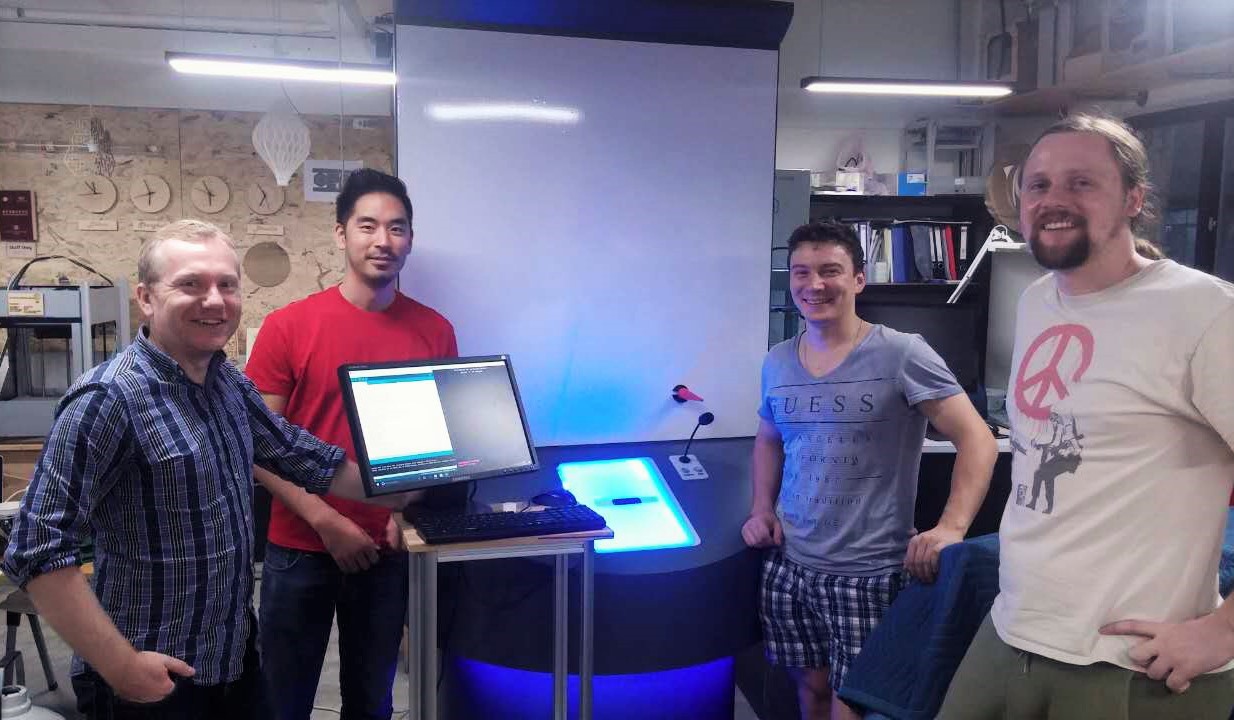 From left to right: Maciej Dudek, Danny Kuo, Ivan Tchekashkin, Sean Purser-Haskell[/caption]
At last Wednesday’s open house the team demonstrated the “Hover Pen” to a mesmerized crowd.
From left to right: Maciej Dudek, Danny Kuo, Ivan Tchekashkin, Sean Purser-Haskell[/caption]
At last Wednesday’s open house the team demonstrated the “Hover Pen” to a mesmerized crowd.
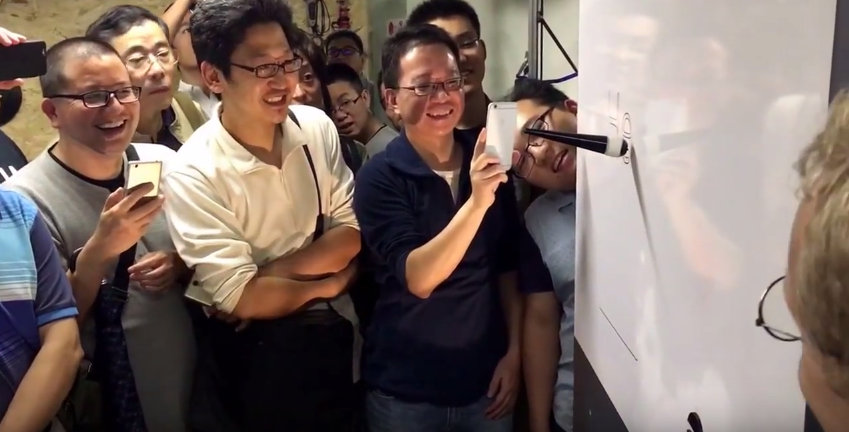 Although it’s easy to use YBCO to levitate small magnets in place – a simple physics demonstration – scaling this property is another story. You quickly encounter problems when asked to achieve a certain level of control, or to “levitate heavy things.” The duo have had to rely on more than just past education and work experience; they’ve had to consider plenty of electromagnetic theory and have frequently risked their fingers playing with magnets and liquid nitrogen.
Although they’ve focused most of their time on issues with superconductor technology, they recognize that putting together the whole system required a large base of knowledge – most gained from past projects at Xinchejian. And without the contributions of Maciej Dudek and Danny Kuo, the demos wouldn’t have their clean form or peripheral functions.
Their demos were showcased by a superconductor manufacturer at the China International Industry Fair this past week. Stop by Xinchejian and take a look at the (almost) finished products!]]>
Although it’s easy to use YBCO to levitate small magnets in place – a simple physics demonstration – scaling this property is another story. You quickly encounter problems when asked to achieve a certain level of control, or to “levitate heavy things.” The duo have had to rely on more than just past education and work experience; they’ve had to consider plenty of electromagnetic theory and have frequently risked their fingers playing with magnets and liquid nitrogen.
Although they’ve focused most of their time on issues with superconductor technology, they recognize that putting together the whole system required a large base of knowledge – most gained from past projects at Xinchejian. And without the contributions of Maciej Dudek and Danny Kuo, the demos wouldn’t have their clean form or peripheral functions.
Their demos were showcased by a superconductor manufacturer at the China International Industry Fair this past week. Stop by Xinchejian and take a look at the (almost) finished products!]]>